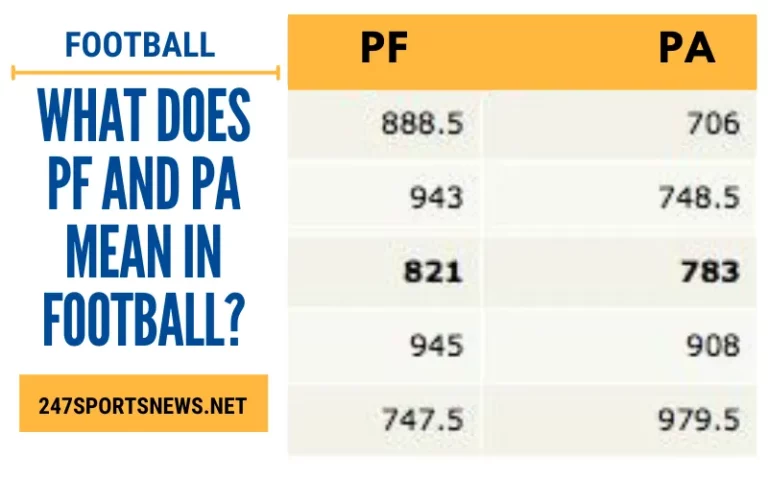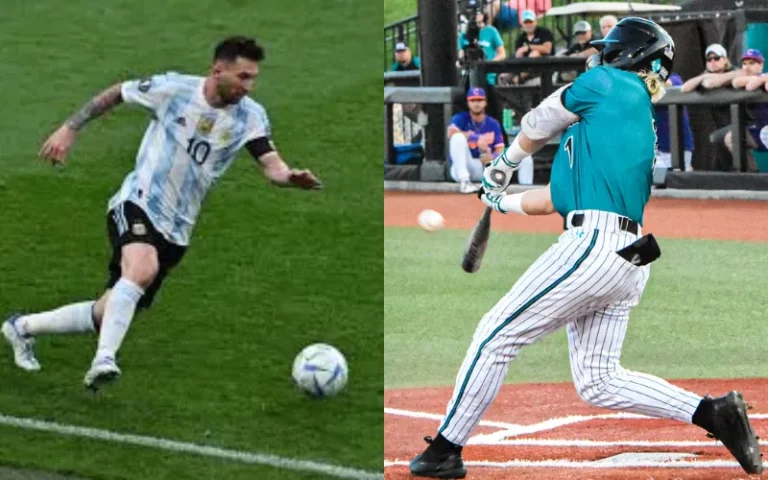Soccer Field Vs Football Field: Complete Comparison Guide
Football and soccer fields have a lot in common at first appearance, yet each has distinctive features. Soccer fields include markers for corner kicks, whereas football fields have goalposts.
So people inquire about how the soccer field vs football field compares. A soccer pitch is 100–130 yards long and 50–100 yards broad. Football fields normally have end zones that are 53.3 yards wide and 120 yards long. Football fields have goalposts in the end zones, but soccer fields do not have marks for touchdowns.
While that provides a general comparison of a soccer and football field, there is much more to explore. It covers everything from different field sizes at different levels to different playing surfaces.
What Is The Difference Between Soccer And Football?
Although American football and soccer are separate sports, they play on similar-shaped fields. However, the two fields have some notable differences that you will see in this article.
Soccer Field Vs Football Field Size
How long is a soccer field? Soccer fields are longer than football fields by 130 yards, making the former the lengthier option. The pitches can be as short as 100 yards. But football fields are 120 yards long.
The width of a gridiron pitch is 53.3 yards, while the other is 100 yards. The width of a soccer field can be as little as 50 yards or 45 meters. Soccer fields are typically larger than football fields when comparing their sizes.
Soccer Field vs. football Field Overlay
Most soccer fields are constructed of natural grass, but others use artificial turf. Many soccer fields are constructed using a mixture of real grass and artificial turf. On the other hand, American football fields are composed entirely of artificial turf or real grass.
The weather, geography, and cost of upkeep mostly influence the selection of the surface. Grass grounds offer more comfortable ball control since soccer games require accurate ball handling.
Football is more of a contact sport; hence it needs more durable, hard-wearing surfaces. It requires soccer players to be flexible to various playing surfaces, which can raise their level of expertise.
Soccer Field Vs Football Field Markings
The field markings on soccer and football fields differ significantly from one another. Due to their wide variation, they are also among the most obvious. Take a deeper look.
The marks, which categorize the field into several sections, all have a purpose. White lines indicate the boundaries of football and soccer fields, but that is where the similarities end.
Markings can refer to several things, including the end zone, the center area, or other yard marks. Let’s examine the field markings that football and soccer fields have and what they mean.
Soccer Field Markings
On a soccer pitch, there are typically additional markers with various purposes. The number of lines is lower than on a football field, though. Here are some of the most significant markings for soccer fields:
- The center of the field mark with a little circle is the Center spot. It’s the place where the game kicks off.
- A circle with a 10-yard radius is known as the center circle.
- The soccer field is split in half by the halfway line. A different name for it is the middle line.
- Each goal has a dot in front of it that designates a penalty spot, where penalties kick.
- A penalty is given when the other side commits a foul in the rectangular area before each goal, where the goalie can touch the ball with their hands.
- Within the penalty area is the goal area, a more condensed rectangular space.
- Its function is to designate the location of a goal kick and serve as a catch area for errant balls.
- Every corner of the playing surface has a corner arc. Corner kicks also take When crossing the goal line at the far end of the field.
Football Field Markings
On a football pitch, significantly fewer markings have significance, but there are more lines and markings overall. The most notable football field markings are shown here:
- The 10-yard line is a set of 10 white vertical lines that extend from 10 to 50 yards before returning to 10.
- On the field, there are five-yard markers every five yards. The yard line gets shorter the closer you get from the 50-yard line toward the end zone.
- Small lines called 1-yard hash marks indicate the 1-yard intervals between each 5-yard line running from sideline to sideline.
- The scoring area on the field is the end zone. The area inside the sidelines lies between the end and goal lines. On each end of the field, there are two end zones.
- The numbers <10, <20, <30, <40, 50, 40>, 30>, 20>, 10> and 10 appear every ten yards.
Soccer Field Vs Football Field Lines
Depending on the area and level of play, soccer grounds may have either natural grass or artificial turf surfaces. The sidelines, goal lines, center circle, and penalty areas are just a few of the lines that delineate the field.
These lines aid both players and officials in locating the boundaries and comprehending their positions during play. Soccer and football pitches can be made from real grass or synthetic turf. Goal lines, end zones, hash marks, and yard lines are markers for players and officials to stand in during play.
Soccer Field Vs Football Goal Post
The two games’ different goalposts are the final and most obvious distinction. Naturally, the goalposts in American football are raised high in the air, 35 feet high, and need to be 18 feet apart. But the while perched on the crossbar, which must be 10 feet high. The goalposts of soccer must be 8 yards apart and have a crossbar that is 8 feet high.
Is It Possible To Use A Football Field For Soccer?
It is possible to play soccer on a football field, and high schools and colleges in the US sometimes have fields that specifically support both sports. A 120-yard football field will fit exactly within a soccer field because football and soccer fields are the same size.
The breadth is a little more difficult since the soccer field is typically wider than the football field. While football grounds must be 160 feet/53 1/3 yards wide, soccer fields can be as little as 50 yards across, though most are more realistically closer to 75 yards.
To play football on a soccer field and vice versa, several schools and universities fix this by utilizing the team sections used during a football game to generate extra width.
Soccer Field Compared To Basketball Court
Two of the most popular sports in the world, basketball, and soccer, are enjoyed by spectators from all walks of life. These contact sports have one thing in common: you must continually move around the playing area, which is physically taxing.
These two sports rank among the riskiest team sports in the world. This section will compare and contrast a basketball court and a football field regarding size and other factors.
Basketball Court Vs Soccer Field Size Difference
The primary distinction between a basketball court and a soccer field is size. If you still need to learn, soccer fields are larger because the sport requires passing the ball and other actions that call for a sizable area. Soccer fields must be large enough for players to move freely and perform at their peak.
Basketball Court Vs Soccer Field Game Duration Difference
Soccer matches play on 131 X 87-yard synthetic fields with 27 to 28-inch balls, lasting 90 minutes on average. Conversely, basketball games last an average of 48 minutes on wooden courts measuring 28 by 15 meters.
Basketball Court Vs Soccer Field Technical Differences
Soccer fields and basketball courts also have two sides each. However, basketball players need to precisely placed in the middle of the court because of the size of the court. It allows players to move swiftly to and from their court; their game mechanics are very different.
These sports field size comparisons are an excellent method to determine whether an activity is physically demanding, as you can see from that fact alone. Basketball can be perfect if you would rather not sprint over large areas. In contrast, you will excel in soccer with greater long-run endurance.
Yes, a soccer field in America is 300 feet by 160 feet in size. A baseball field has walls in the outfield on the left and right field foul lines that are 325 feet and 400 feet from home plate, respectively. So you can see which one is bigger.
Soccer players occasionally get serious injuries, although this is far less common than in football. It usually results in the athletes’ careers lasting longer and being in better health, which is encouraging for the fans.






